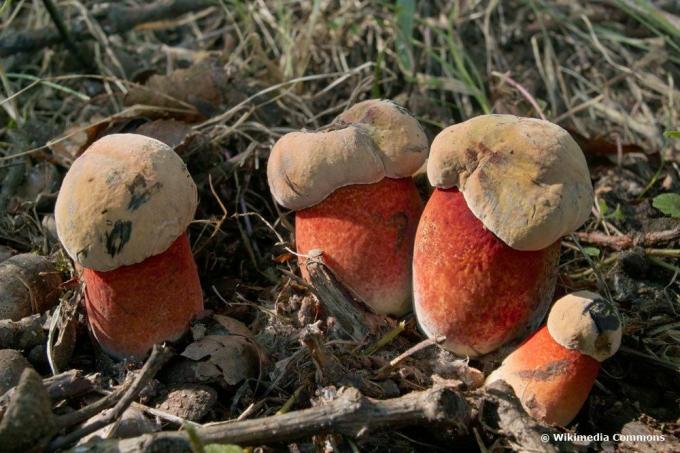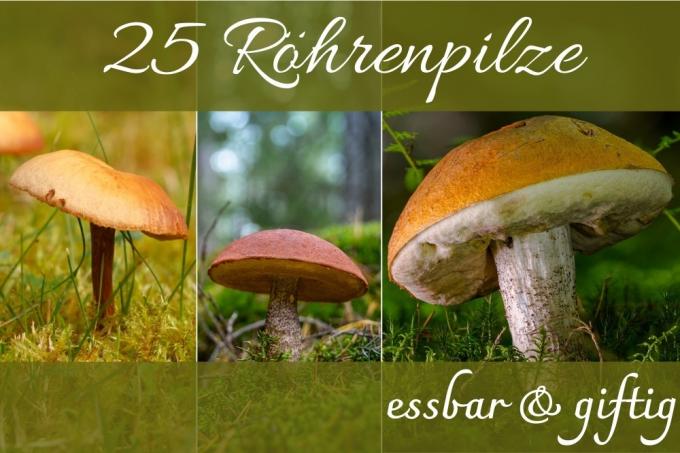
table of contents
- Boletus
- Brown caps
- Red caps
- Dregs
- Xerocomellus
- Other tubular mushrooms
- Poisonous doppelgangers
Röhrlinge are types of fungus, the hats of which have a spongy fabric underneath. The species belong to the families of the thick boletus and smeared boletus relatives. Few species are poisonous, which is why tubular mushrooms are popular beginner mushrooms.
Boletus
They are characterized by a conspicuous growth habit. Porcini mushrooms appear compact with bulbous stems on which initially domed and later cushion-shaped to hemispherical hats grow. The pulp has a mild mushroom taste, which is rounded off by a nut to almond-like aroma. There are numerous tubular mushrooms, which laypeople refer to as boletus because of their difficulty in distinguishing them. These stand out from similar generic representatives by initially white and with age pale yellow tubes. If you cut the pulp, it will not discolour, but will stay light.
Birch boletus
- scientific name: Boletus betulicola
- very good edible mushroom with a pleasant aroma
- Hat: light, ocher-brown to bronze-colored, feels damp and greasy with age
- Stem: brownish with white network markings
- Tubes: initially whitish, later deep yellow to ocher yellow
- Habitat: deciduous forests with birch trees
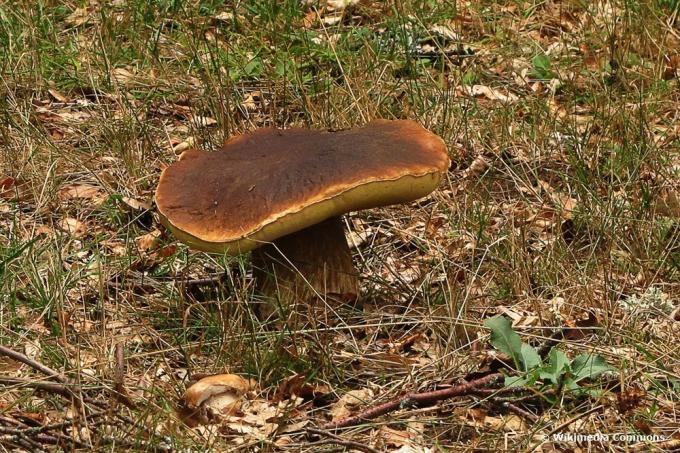
Oak boletus
- scientific name: Boletus aestivalis
- one of the few boletus that can also be eaten raw
- Hat: finely felt-like, variable brown color
- Stem: hazel to leather brown, raised net and colored light brown to white
- Tubes: initially whitish, later creamy-yellow to green-yellow
- Habitat: deciduous forests with beech and oak
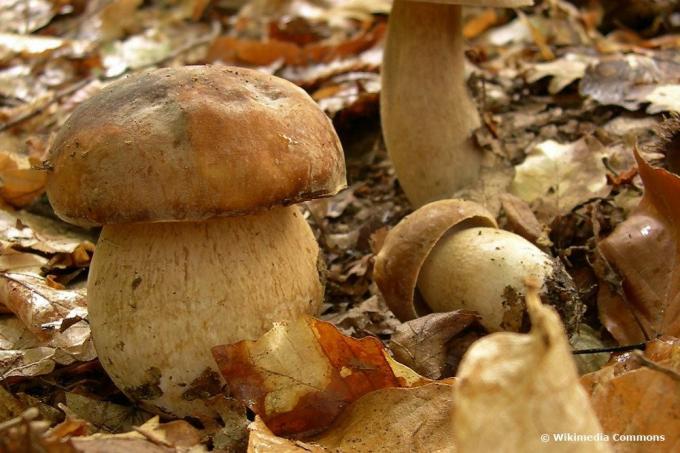
Spruce boletus
- scientific name: Boletus edulis
- can also be consumed raw
- Hat: hazelnut to chestnut brown, rarely red to dark brown, always with a yellowish-white edge
- Stem: white to brownish with a fine white network
- Tubes: initially whitish, later cream-colored to greenish-yellow
- Habitat: preferably in mixed forests with spruces, pines and firs
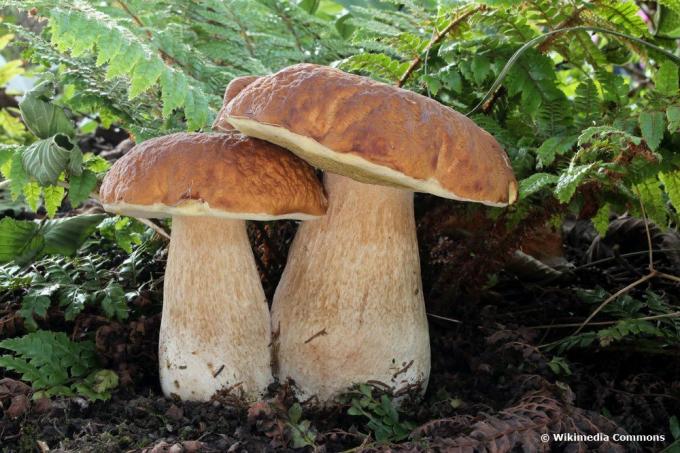
Black-capped boletus
- scientific name: Boletus aereus
- Synonym: bronze bolete
- edible, but relatively rare
- Hat: coffee-brown to almost black with yellow-brown spots
- Stem: pale dark to leather brown with a fine white to light brown network
- Tubes: initially whitish, later cream-colored to green-yellow
- Habitat: warm oak and beech forests

Brown caps
A species that moves on a level with porcini mushrooms from the point of view of food value is also known as a brown cap. Typical of this representative of the boletus is the firm pulp with a whitish to lemon-yellow color, which turns greenish-blue on contact with air. These tubular mushrooms are among the popular and widespread edible mushrooms, the main season of which extends from mid-September to late autumn. Originally, brown caps were counted among the porcini mushrooms, but as a result of intensive research, brown caps are now a species of their own. Their taste is reminiscent of the mild aroma of porcini mushrooms.
Chestnut bolet
- scientific name: Imleria badia, also Boletus badius
- Hat: dark to chestnut brown color, sometimes lighter reddish brown to olive brown
- Stem: brown to yellowish brown and paler than the hat
- Tubes: initially whitish to creamy yellow, later olive yellow to dirty olive green, turning blue on print
- Habitat: preferably spruce forests, also under larches
- Confusion with porcini mushrooms and bile boletus
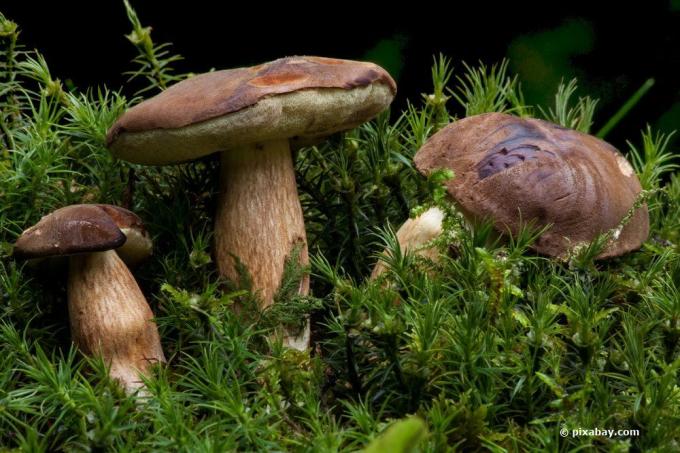
Note: The edible giant dumpling is also known as the brown cap. However, it does not belong to the tubular mushrooms, but is a representative of the mushroom-like.
Red caps
The whitish stem, which is covered with black-brown scales, is typical of these boletus. They are reminiscent of stubborn dirt and make the bark appear dirty. This scaling gave the species, which can easily be confused with one another, the name "rough feet". Young specimens have a bulbous stem that becomes longer with increasing age and appears cylindrical to slightly clubbed. Red caps are very good edible mushrooms with a very pleasant mushroom taste. When injured, their flesh shows variable discolorations ranging from red to pink to blue, green and black.
Note: Even if the pulp of the red caps turns black when cooked, the taste is in no way impaired. The species are unmistakable and clearly distinguishable from poisonous tubular mushrooms.
Birch red cap
- scientific name: Leccinum versipelle
- edible, but should be cooked well through
- Hat: brick-like color, yellow-orange or reddish brown
- Stalk: mostly noticeably thick
- Tubes: yellowish to greyish when young, later lighter
- Habitat: on sandy loam under birch trees
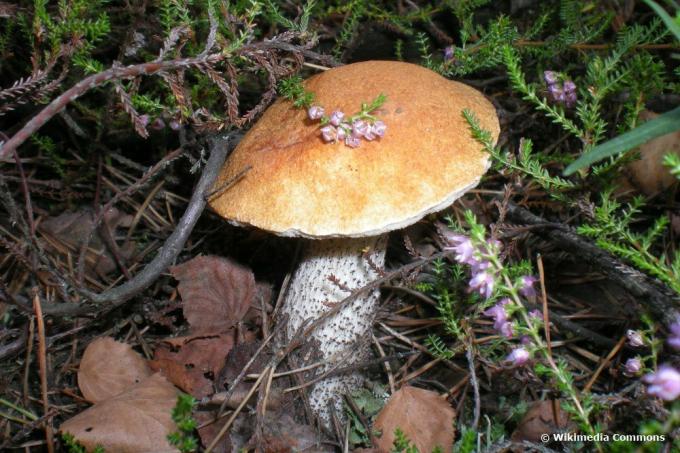
Oak red cap
- scientific name: Leccinum aurantiacum
- excellent taste, better than birch mushrooms
- Hat: yellow-orange, orange-red or orange-brown; rarely ocher to yellow-brown
- Stem: slightly protruding scales that initially appear whitish, later brick-orange
- Tubes: for a long time whitish to light cream-gray in color, only olive to gray-yellow in old age
- Habitat: under aspens and trembling poplars

Common birch mushroom
- Scientific name: Leccinum scabrum, also Boletus scaber
- tastes mild, but slightly sour
- Hat: light gray-brown to reddish-gray-brown, sometimes with yellowish tones
- Stem: slender, tapers towards the top
- Tubes: initially whitish, later gray and very spongy
- Habitat: under birch trees
- frequent confusion with porcini mushrooms

You can contact this user here.
English | español | français | italiano | македонски | മലയാളം | português | +/− derivative work: Ak ccm (talk), 2007-10-13 Leccinum scabrum (Bull.) Gray 12300 crop, edited by Plantopedia, CC BY-SA 3.0
Tip: The pulp of these tubular mushrooms can be easily removed from the tubes. Above all, you should collect the boletus when they are young, because then the meat is relatively firm and does not contain water.
Spruce Red Cap
- scientific name: Leccinum piceinum
- tastes mild and slightly sour
- Hat: brown-red to orange-brown and finely felted
- Stalk: scales become denser downwards
- Tubes: dirty whitish-gray, gray-brown, yellow-brown or brown
- Habitat: under spruce trees, between blueberries
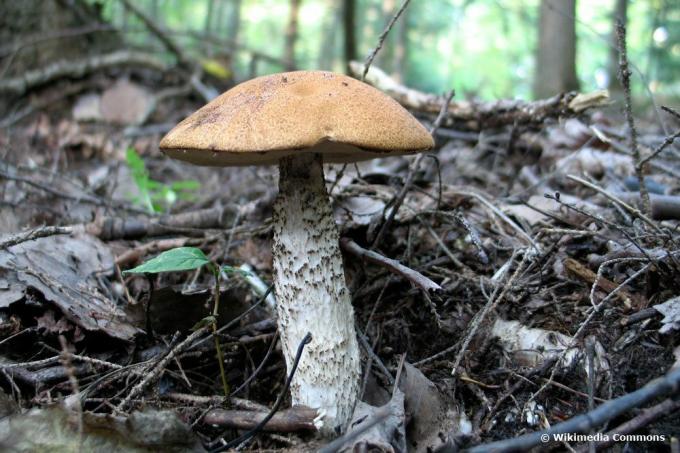
Dregs
Smeared boletus relatives represent the second large family within the boletus. These tubular mushrooms are popular edible mushrooms, and their taste is often mildly sour. They are medium-sized and have a particularly soft flesh. The older the mushrooms get, the greasier the cap skin appears. In some species, however, this remains felty and dry. The butter bolet is considered a type of lubricant bolet. Most of these tubular mushrooms are tied to specific trees.
Butter mushroom
- scientific name: Suillus luteus
- tastes sour, not suitable for sensitive stomachs
- Hat: brown and shiny, very slimy
- Stem: yellow colored with a brownish-violet ring and brownish dots
- Tube mushrooms with lemon-yellow tubes
- Habitat: under pines
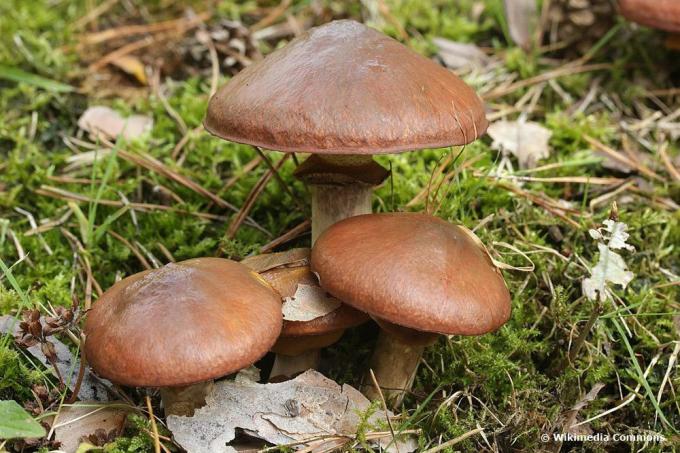
Goldröhrling
- scientific name: Suillus grevillei
- Synonyms: golden yellow larch tubule, golden cap
- edible, but tastes bland and sometimes musty
- Hat: golden to orange-yellow, occasionally orange to rust-brown or lemon-yellow
- Stem: dark orange to brownish below, colored like the tubes above the ring zone
- Tubes: initially yellow, later brownish
- Habitat: under larches

Sandröhrling
- scientific name: Suillus variegatus
- Synonyms: velvet boletus, millet mushroom
- pleasantly mild and mushroom-like aroma
- Hat: yellow to olive ocher, granular to tomentose, slightly roughened to matt
- Stalk: yellowish and finely brown-grained frosted, slightly to medium-strong blue discolouration when injured
- Tubes: initially brownish to rusty yellow, later dirty olive brown
- Habitat: under pines
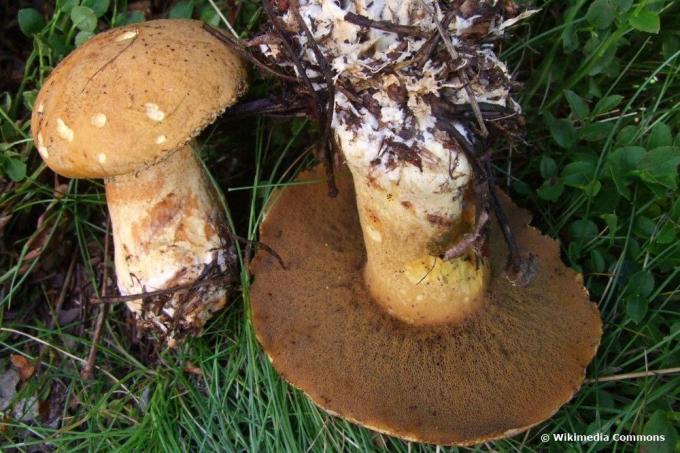
Xerocomellus
These tubular mushrooms are smaller and slimmer than porcini mushrooms. Even in rainy weather, your hat skin is not slimy, but dry. The hat is centrally stalked, the narrow stem is very soft and has little or no bark. Occasionally this appears with vertical stripes. Typical of red-footed boletus is the lively coloration and the felty hat skin. Their pulp tastes mild. Since they do not form a typical network, they can easily be mistaken for poisonous species.
Common red-footed bolete
- scientific name: Xerocomellus chrysenteron
- Recommended as a mixed mushroom because of its sour aroma
- Hat: brownish, felt-like to velvety skin, tears open later, hat looks cracked with reddish furrows
- Stem: reddish dotted and flocked, net markings missing
- Tubes: yellow to olive yellow
- Habitat: mixed forests
- Confusion with gallbladder
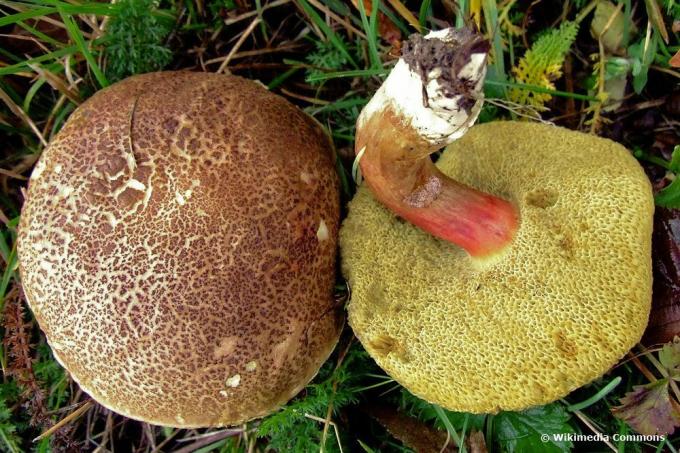
Wrong red foot
- scientific name: Xerocomellus porosporus
- Synonyms: Gloomy red-footed bolete
- mild and slightly sour taste, takes on the aroma of other mushrooms
- Hat: nut-brown to beige, tomentose and tearing, furrows less red in color than other red-footed boletus
- Stem: yellowish to white-gray or gray-yellow, only rarely reddish dots
- Tubulars with yellow-colored tubes
- Habitat: mixed forests
- Confusion with gallbladder
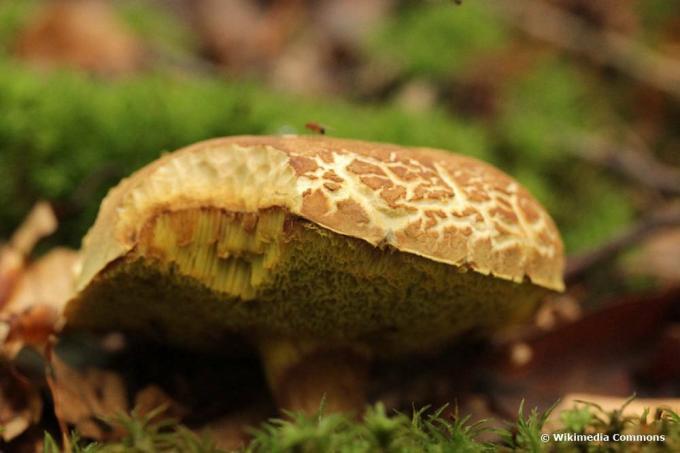
Autumn red foot
- scientific name: Xerocomellus pruinatus
- Synonym: Frosted red-footed bolete
- tastes sour, but less badly than other red-footed boletus
- Hat: brownish and tomentose, tearing open, later with red furrows
- Stem: reddish dotted to flaky, but without network markings
- Tubes: yellow
- Habitat: mixed forests
- Confusion with gallbladder
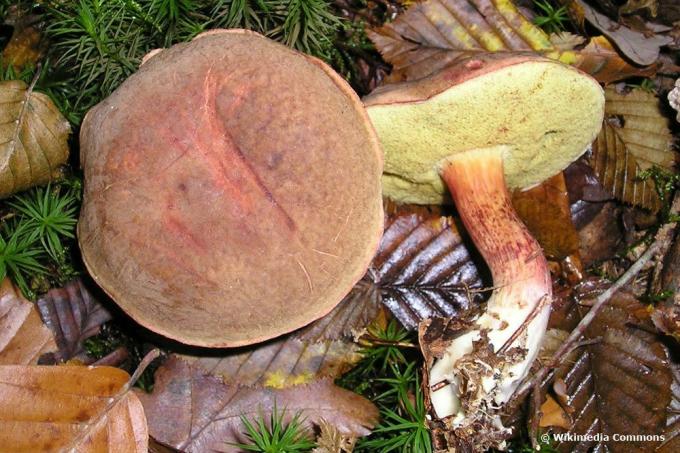
Other tubular mushrooms
Numerous mushrooms were originally counted among the porcini mushrooms, which can be recognized by the synonymous scientific names. Species of the genus Neoboletus have strong similarities to porcini mushrooms. Their flesh is firm and pale to light yellow in color. If it is injured or squeezed, it quickly turns dark blue.
Flaky-stemmed witch's bolete
- scientific name: Neoboletus luridiformis
- Synonym: gypsy
- generous boletus with a mild and pleasantly mushroom taste
- Hat: dark brown, rarely light brown with olive green nuances
- Stem: yellow to brownish yellow in color, covered with fine flakes
- Tubes: yellowish with an olive green tinge, pressure points turn blue
- Habitat: more common forest mushroom, preferably under conifers
- Confusion with Satan's Röhrling
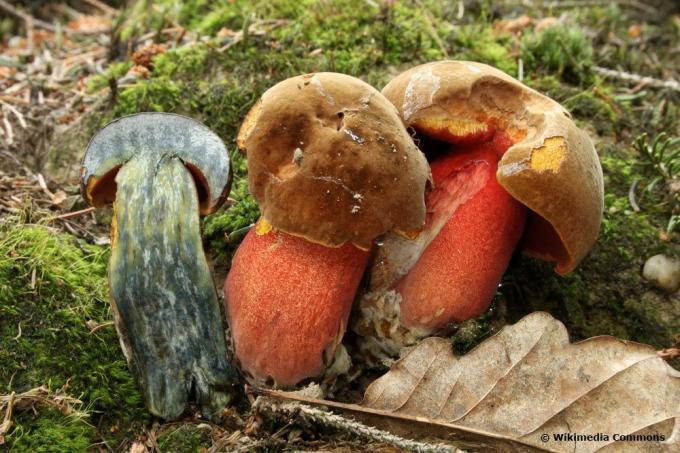
Smooth-stemmed witch's bolete
- scientific name: Suillellus queletii, also Boletus queletii
- very rare tubular mushrooms with a mild taste
- Hat: from brownish and ruby red, through brick to copper and dark carmine red
- Stem: colored light yellow at the top, wine to garnet red at the bottom, finely powdered
- Tubes: initially lemon yellow, later golden yellow and finally pale olive green
- Habitat: deciduous forests and parks
- Confusion with Satan's boletus, flaky-stemmed witch bolete
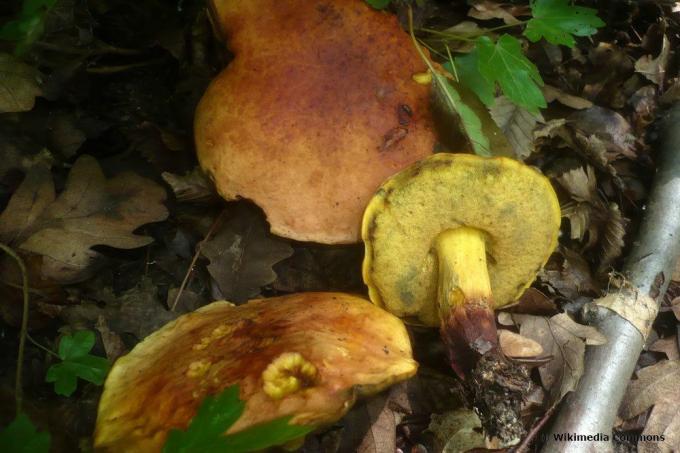
You can contact this user here.
English | español | français | italiano | македонски | മലയാളം | português | +/−, 2012-07-22 Boletus queletii Schulzer 253584, edited by Plantopedia, CC BY-SA 3.0
Pepper boletus
- Scientific name: Chalciporus piperatus, also Boletus piperatus
- peppery hot, sharpness decreases a little when drying and cooking
- Hat: red-brown colored, uneven to slightly hunched and felty or sticky
- Stem: remarkably thin, brownish to yellowish on the outside, yellow on the inside
- Tube mushrooms with large pores and brown to red-brown tubes
- Habitat: mixed forests, preferably on acidic soils
- Risk of confusion: hardly to be confused

Goat lip
- Scientific name: Xerocomus subtomentosus, also Boletus subtomentosus
- Synonyms: Mushrooms are also known as felty boletus
- mild edible mushroom
- Hat: gray-brown, subtle pink under the hat skin, felty hat skin
- Stem: long and slender, slightly brownish mottled to almost completely white, with age the tip is twisted and reddish
- Tubes: initially chrome to ocher yellow, later yellow to green brown, occasionally slightly bluish
- Habitat: mixed forests
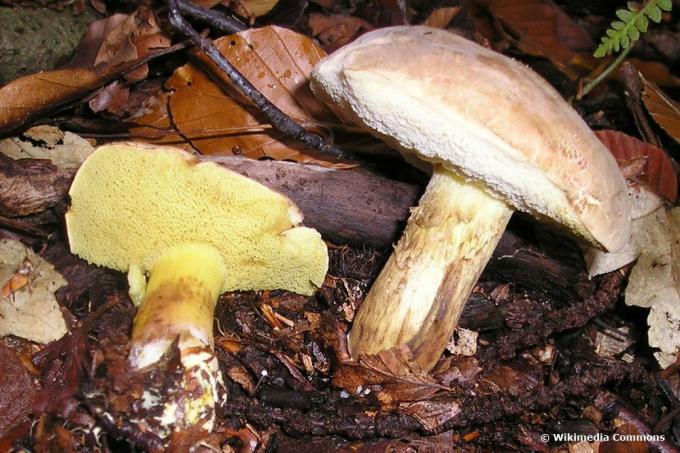
Poisonous doppelgangers
Poisonous tubular mushrooms belong to different genera and are characterized by typical characteristics. The combination of a reddish hat with yellow tubes and a reddish net on yellow stems is characteristic of the species of the genus Rubroboletus, to which the Satan's boletus belongs. When injured, the pulp turns blue. This lively color combination is shared by species of this genus with the Caloboletus mushrooms. They also have yellow tubes. The cap skin, which is covered by interwoven fungal threads, is typical of these species. Their flesh turns blue when injured and tastes clearly bitter. In order to distinguish toxic and inedible types of edible mushrooms, various characteristics should be examined more closely.
Bitter boletus
- scientific name: Caloboletus radicans
- Synonyms: rooting bitter boletus, bitter sponge
- Tube mushrooms are considered inedible because of their strong bitterness
- Hat: gray to gray-white or brown-gray, spotted
- Stem: yellowish with yellow-brownish network, gets reddish to brownish-red spots when pressed
- Tubes: yellowish to olive yellow, pressure points intensely blue discolouring
- Habitat: deciduous forests, under oaks, beeches and linden trees
- Confusion with porcini mushrooms
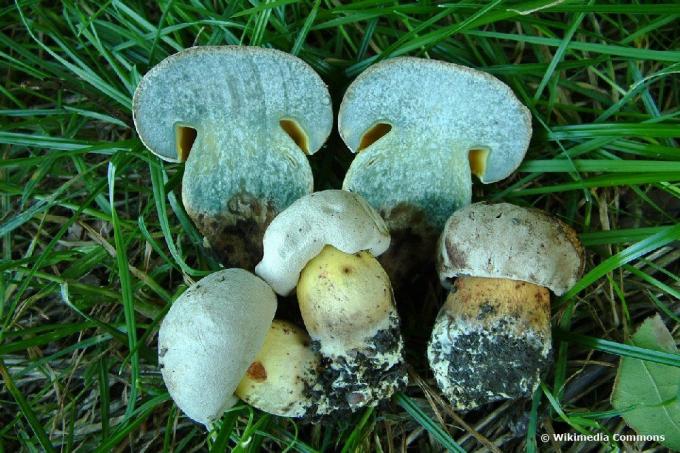
Gallbladder
- scientific name: Tylopilus felleus
- Synonyms: common bile boletus, bitter boletus, bitter mushroom
- Because of their strong bitterness, boletus are considered inedible, although mild variants also occur
- Hat: light brown, sometimes dark brown
- Stem: light brownish with a brown net, lighter towards the top
- Tubes: initially white, later pink, turns dark pink when pressed
- Habitat: mixed and coniferous forests, preferably on acidic soils
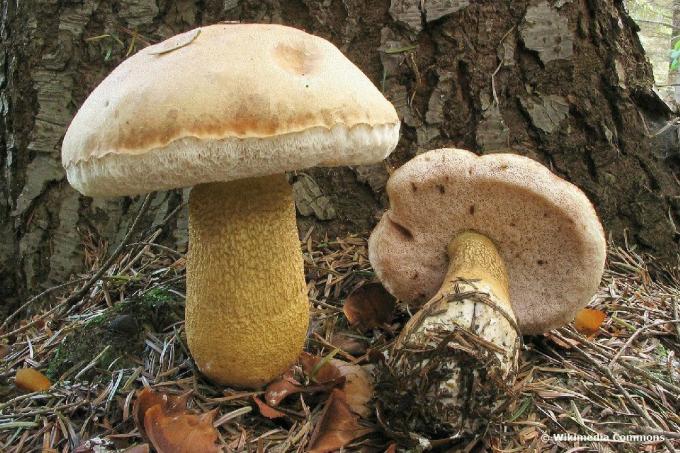
Net-handled witch bolete
- scientific name: Suillellus luridus
- Synonyms: Red Stocking, Saupilz, Netzhexe
- Tube mushrooms are poisonous if alcohol is consumed at the same time, otherwise edible
- Hat: light to dark brown or leather-colored to gray-brown, often with an olive shade, surface bluish and velvety to sticky
- Stem: with reddish to red- or dark-brown net markings on a yellowish background, often with a shiny reddish tinge
- Tubes: yellow, orange-yellow to almost wine-red
- Habitat: deciduous forests
- Confusion with flaky-stalked witch bolete or Satan's bolete

Satan's Röhrling
- scientific name: Rubroboletus satanas
- Synonyms: devil mushroom, satan's purple boletus
- poisonous tubular mushrooms with a mild taste
- Hat: initially gray-white to gravel-stone-colored, older ocher, leather-colored to greenish and irregularly curved
- Stem: distinctly red to blood red network on a yellow background
- Tubes: first pale yellow, finally green-yellow to pale blue-green
- Odor: weak when young and later intensely carrion-like
- Habitat: deciduous forests, preferably on calcareous soils
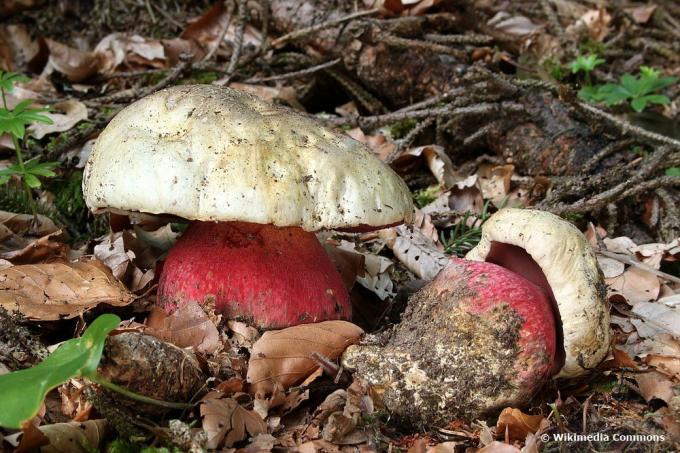
Schönfußröhrling
- scientific name: Caloboletus calopus
- Synonyms: Hantling, Dickfußröhrling, Dickfuß
- poisonous tubers
- Hat: clay-gray to clay-colored, dry and velvety, irregularly wavy
- Stem: typically thick-footed to slightly clubbed, yellowish at the tip, reddish towards the base of the stem, with a reddish brown net
- Tubes: yellowish, blue on pressure
- Habitat: mixed forests and coniferous forests
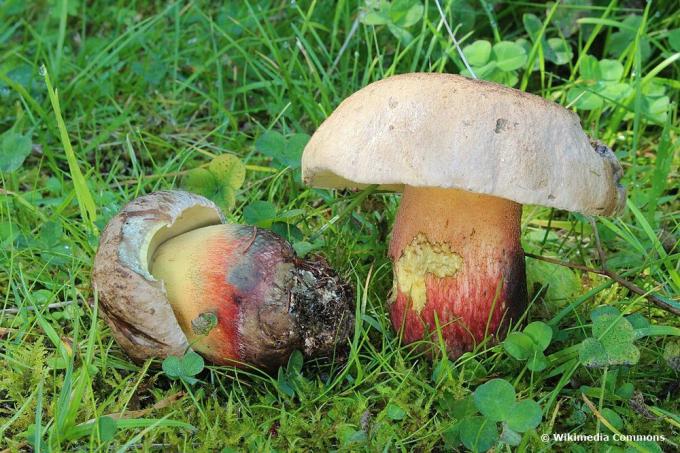
Deceptive witch mushroom
- scientific name: Suillellus mendax
- Synonym: short-nosed witch bail
- are poisonous with alcohol, but can be consumed when cooked
- Hat: dark brown to wine red or olive brown to gray brown, velvety to sticky,
- Stem: reddish brown to dark brown net markings
- Tubes: orange-red
- Habitat: deciduous forests
